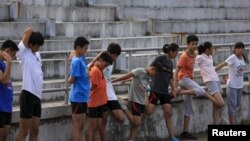A new report finds most adolescents around the world do not get enough physical activity on a daily basis to be healthy and to stay healthy as adults. This World Health Organization study presents the first-ever global estimates of insufficient physical activity among adolescents ages 11 to 17.
Data for this study was collected from 1.6 million adolescents across 146 countries. It finds girls were less active than boys in all but four countries —Tonga, Samoa, Afghanistan and Zambia.
The report says the biggest gender gaps are seen in the United States and Ireland where 15 percent more girls than boys were physically inactive. The World Health Organization recommends adolescents do moderate or vigorous exercises for one hour every day of the week to stay fit.
Benefits of exercise
Regina Guthold is a scientist in the WHO’s Department of Maternal, Newborn, Child and Adolescent Health, and lead author of the study. She says the 60-minute workouts can be split into three segments of 20 minutes a day for health benefits to kick in.
“They get better heart health,” she said. “They have better respiratory fitness. They have better cognitive function too — easier learning. They have better pro-social behavior. And, it is likely that the benefits track into adulthood, meaning that active adolescents are likely to be active adults and then they get the heath benefits as adults as well.”
Guthold says any kind of physical activity is good. This could include walking or biking to school, team sports, dancing, active domestic chores, physical education and planned exercise.
The study finds young people everywhere in the world do not exercise enough. Data shows that 85 percent of girls and 78 percent of boys do not meet the current WHO recommendations of at least one hour of physical activity a day.
Electronic revolution
The co-author of the study, Leanne Riley, cites some of the causes behind this high level of inactivity.
“We have had this electronic revolution that seems to have changed adolescents’ movement patterns and encourages them to sit more, to be less active, to drive more, walk less, be less active in general and then be more involved in digital play rather than the active play,” she said.
WHO says schools should encourage physical education and get students to be more active in competitive and non-competitive sports. It recommends city and community leaders should create paths for young people to walk and cycle safely and independently.
It says urban planning also has a big role to play in designing safer, recreational play areas in parks for young people.




